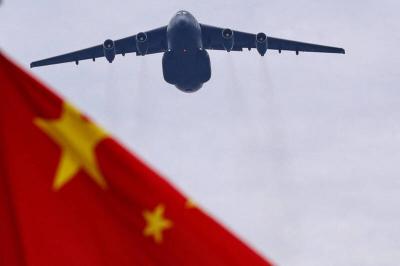The “new” arms package recently touted by US officials has yet to be confirmed by US President Barack Obama. Nevertheless, supporters of Taiwan are already hailing the news as a great victory, of Obama “thumbing his nose at the Chinese,” as Foreign Policy recently put it.
There are signs, however, that there is less to the news than meets the eye.
From what has been made public, the Obama administration could release PAC-3 interceptor missiles, UH-60 Black Hawk helicopters, as well as an operations deal for the “Po Sheng,” or Broad Victory, command and control program and design work on diesel-electric submarines.
Not only are the 66 F-16C/D fighter aircraft that Taiwan has sought for years missing from the list, however, there is also nothing new in the “new” arms package proposed by the administration.
“The real question,” Wendell Minnick, Asia Bureau Chief at Defense News, told the Taipei Times on Sunday, “is what is ‘new’ in the arms pipe that hasn’t been in there since 2001. And there is nothing, which is ominous.”
All these items were approved by former US president George W. Bush in 2001. Also problematic is the fact that the design work on the submarines would be both costly and may not even result in actual subs. Even if it did, it would only be many years from now and make an insignificant contribution to Taiwan’s current and mid-term defense requirements.
MISSILES
Furthermore, given the two-to-one ratio required for PAC-3 missiles to shoot down a target, even the addition of the 330 missiles included in the Bush package would be insufficient to ensure full coverage in case of a Chinese barrage.
China’s arsenal, which has been growing by about 100 missiles annually, is about 1,500. A barrage would easily overwhelm Taiwan’s defense capabilities and even a limited attack could quickly deplete its defense stocks.
“It’s simple math,” Minnick said. “Four fire units of PAC-2s procured 10 years ago are being upgraded, but even so, each unit has four missiles, so that’s 16 total missiles that can be fired.”
“It takes 30 minutes to reload one fire unit. So you are down to eight PAC-2 missiles per attack. The Chinese just upped the number of SRBMs [short-range ballistic missile] to overwhelm them. Now Taiwan is getting new PAC-3s. But even if they get the six fire units originally released by Bush, that’s only 24 missiles, plus 16 original PAC-2s — that’s 40 [altogether]. With two missiles dedicated to incoming SRBMs ... that’s really only 20.”
In addition, Beijing could use the announcement of the PAC-3 sale as an argument to continue building up its missile arsenal, which would offset the small advantage created by the purchase.
The price tag for 330 PAC-3 missiles and related equipment is estimated at US$3.1 billion, while each DF-15 missile deployed by China costs about US$450,000, excluding launchers and related equipment. To draw a comparison, 330 DF-15 would cost China US$148 million. By taking the two-to-one ratio into consideration, it would cost China US$74 million to deplete US$3.1 billion worth of PAC-3s — a cost disparity that makes a strong case against the advisability of the PAC-3s purchase in the first place.
Still, some US defense analysts see some benefits to the PAC-3s, as they would be “speed bumps” in a conventional Chinese military campaign and serve to undercut coercive use of force.
Symbolically, the PAC-3s also imply an operational linkage with the US, as US satellite warning is presumably part of the equation.
ILLUSION
The Obama administration’s position on arms sales to Taiwan is increasingly looking like a half-hearted effort to “prove” that it remains committed to Taiwan, while limiting sales to systems that do not really tilt the balance in the Taiwan Strait, thus ensuring that Beijing’s “anger” will be minimal and likely not result in China cutting military-to-military ties with the US.
Asked for comment on the possible Obama deal, John Tkacik, a retired US foreign service officer and expert on China, said: “The Obama administration’s breath-taking concessions — not just on Taiwan, but on Tibet, human rights, Iran and North Korea — at the Obama-Hu [Jintao (胡錦濤)] meetings last month have generated pushback in Washington. So now Obama’s people are doing the least they can get away with, and now they are looking at anodyne moves that won’t really make a difference.”
“Of course, their intent — like Ma’s — is to avoid riling China. Any US arms sales, then, are likely to be of marginal use in redressing the already catastrophic imbalance in the Taiwan Strait,” Tkacik said.
“I suspect that if Obama approves a new arms package, Ma’s government and the [Chinese Nationalist Party, KMT]-dominated Legislative Yuan will, once again, go out of its way to temporize, shilly-shally and complain about the costs, utility, and political tensions with China of the sales — and use those factors as excuses to stall procurements. That way, Obama can say ‘it’s Taiwan’s fault’ and [President] Ma [Ying-jeou (馬英九)] will say ‘it’s the Americans’ fault.”
If Obama took Taiwan’s defense seriously, his administration would be releasing the types of weapons that would help Taiwan mount a credible deterrent force, not costly material whose utility and desirability is increasingly questionable.
The sale of 150 F-16A/Bs in 1992 by George H.W. Bush is an example of real commitment. In one swoop, the sale altered the balance of power in the strait and ensured that Beijing would have neither the numerical nor qualitative advantage that would make the use of force a viable option. A case could be made that this helped ensure there would be no war in the Taiwan Strait for a decade.
Taiwan now finds itself in a position where it has to beg for arms that would only have a marginal impact on the balance of power in the Taiwan Strait. There is also evidence, Tkacik said, that Ma administration officials in Washington “refrained from pushing Bush or Obama on the F-16s and slow-balled just about everything else” or even “pointedly refused to raise the F-16s.”
The cost of the items set for release by Obama is prohibitively high and represents a substantial proportion of Taipei’s defense budget. In addition, because of Washington’s refusal to sell it advanced weapons, Taipei is now forced to spend large sums to upgrade its aging F-16 fleet, as well as its Lafayette-class destroyers, Ching-kuo Indigenous Defense Fighters and Dutch submarines as it retires some of its Mirage 2000s and F-5s. Added to the investment that will be required to turn the military into an all-volunteer force, as Ma has called for, it is becoming increasingly doubtful that Taiwan can afford all these items.
“The KMT legislature blocked Taiwan’s military procurements during the Chen Shui-bian (陳水扁) years, and thus ensured Taiwan’s long-term defenselessness against China. And it seems now that neither Ma nor Obama intend substantively to reverse that,” Tkacik said.

Beijing could eventually see a full amphibious invasion of Taiwan as the only "prudent" way to bring about unification, the US Department of Defense said in a newly released annual report to Congress. The Pentagon's "Annual Report to Congress: Military and Security Developments Involving the People's Republic of China 2025," was in many ways similar to last year’s report but reorganized the analysis of the options China has to take over Taiwan. Generally, according to the report, Chinese leaders view the People's Liberation Army's (PLA) capabilities for a Taiwan campaign as improving, but they remain uncertain about its readiness to successfully seize

Taiwan is getting a day off on Christmas for the first time in 25 years. The change comes after opposition parties passed a law earlier this year to add or restore five public holidays, including Constitution Day, which falls on today, Dec. 25. The day marks the 1947 adoption of the constitution of the Republic of China, as the government in Taipei is formally known. Back then the Chinese Nationalist Party (KMT) governed China from Nanjing. When the KMT, now an opposition party in Taiwan, passed the legislation on holidays, it said that they would help “commemorate the history of national development.” That

HORROR STORIES: One victim recounted not realizing they had been stabbed and seeing people bleeding, while another recalled breaking down in tears after fleeing A man on Friday died after he tried to fight the knife-wielding suspect who went on a stabbing spree near two of Taipei’s busiest metro stations, Taipei Mayor Chiang Wan-an (蔣萬安) said. The 57-year-old man, identified by his family name, Yu (余), encountered the suspect at Exit M7 of Taipei Main Station and immediately tried to stop him, but was fatally wounded and later died, Chiang said, calling the incident “heartbreaking.” Yu’s family would receive at least NT$5 million (US$158,584) in compensation through the Taipei Rapid Transit Corp’s (TRTC) insurance coverage, he said after convening an emergency security response meeting yesterday morning. National

Taiwan has overtaken South Korea this year in per capita income for the first time in 23 years, IMF data showed. Per capita income is a nation’s GDP divided by the total population, used to compare average wealth levels across countries. Taiwan also beat Japan this year on per capita income, after surpassing it for the first time last year, US magazine Newsweek reported yesterday. Across Asia, Taiwan ranked fourth for per capita income at US$37,827 this year due to sustained economic growth, the report said. In the top three spots were Singapore, Macau and Hong Kong, it said. South